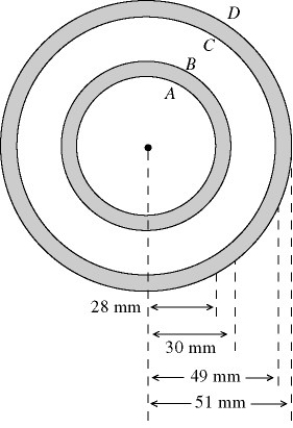Lines of charge: The cross section of a long coaxial cable is shown in the figure, with radii as given. The linear charge density on the inner conductor is  and the linear charge density on the outer conductor is
and the linear charge density on the outer conductor is  The inner and outer cylindrical surfaces are respectively denoted by A, B, C, and D, as shown.
The inner and outer cylindrical surfaces are respectively denoted by A, B, C, and D, as shown.  The radial component of the electric field at a point that 34 mm from the axis is closest to
The radial component of the electric field at a point that 34 mm from the axis is closest to 
A) - 16,000 N/C.
B) + 16,000 N/C.
C) - 37,000 N/C.
D) + 37,000 N/C.
E) zero.
Correct Answer:
Verified
Q31: Charge on conductors: A hollow conducting spherical
Q32: Spheres of charge: A nonconducting spherical shell
Q33: Lines of charge: Charge is distributed uniformly
Q34: Spheres of charge: A non-conducting sphere of
Q35: Spheres of charge: Electric charge is uniformly
Q37: Spheres of charge: Electric charge is uniformly
Q38: Charge on conductors: A hollow conducting spherical
Q39: Spheres of charge: A solid nonconducting sphere
Q40: Charge on conductors: A hollow conducting spherical
Q41: Charge on conductors: An irregular conductor carries
Unlock this Answer For Free Now!
View this answer and more for free by performing one of the following actions

Scan the QR code to install the App and get 2 free unlocks

Unlock quizzes for free by uploading documents